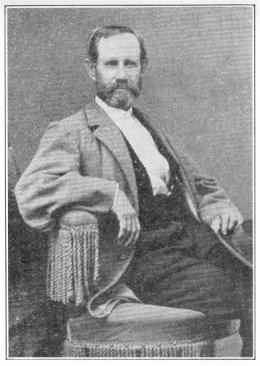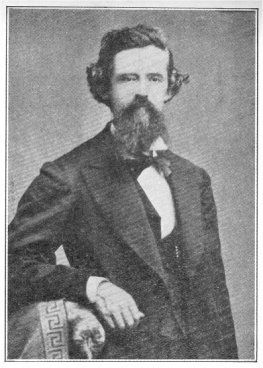
[click to enlarge]
Captain John S. Diltz,
outstanding pioneer miner.
| Online Library: | Title | Author | California | Geology | History | Indians | Muir | Mountaineering | Nature | Management |
Yosemite > Library > Call of Gold > 24. Mariposa around 1859 >
Next: 25. Gazette News • Contents • Previous: 23. John S. Diltz
J. M. Hutchings is speaking: “Mariposa is the most southerly of all mining towns of importance in the State. The population is about 1300 or about one-seventh of the entire County. Being an excellent starting point to the Yosemite Valley and the Mariposa Grove of mammoth trees, it is likely to become a place famous in history and the note-books of travelers.
“The Mariposa route was the first and original route ever travelled to the Yosemite Valley; and its fearless people the first to enter it, in pursuit of the murderous and marauding Indians, in 1851; and, afterwards, to make the existence of such a marvelous spot known abroad. The great public, therefore, throughout the civilized world, owe an agreeable, enduring and never-to-be-cancelled debt of gratitude to the people of Mariposa for the glorious heritage they were thus instrumental in conferring upon them.
“The neat and tastefully cultivated gardens, in the vicinity, give an air of freshness and home-like brightness that some other places we might mention would do well to imitate. The distance from Stockton to Mariposa is 92 miles and the road good, upon which a line of stages is running. On alternate days, at six o’clock in the morning, a stage leaves Stockton, arriving in Hornitos the same evening and Mariposa about eleven A. M. the day following.
“Large freight wagons have nearly superseded the pack-trains; these have, not inappropriately, been denominated ‘prairie schooners’ and ‘steamboats of the plains’. One team, belonging to Mr. Warren, has taken one hundred thousand pounds to Mariposa from Stockton, in four trips.
“The cost of these wagons is from nine hundred dollars to eleven hundred and fifty dollars. In length, they are generally from twenty to twenty-three feet on the bottom. Mules cost upon the average three hundred and fifty dollars each; and some very large ones sell as high as fourteen hundred dollars the span.
“One man drives and tends as many as fourteen animals, guiding and driving with a single line. It would be a source of considerable amusement, to our Eastern friends, could they see how easily these large mules are handled. They are drilled like soldiers and are almost as tractable. When a teamster cracks his whip, it sounds like the sharp, quick report of a revolver and is nearly as loud.”
The Pine Tree Hotel was built in 1859. It was so-named on account of an immense pine tree growing alongside. This was trimmed of its branches and used as a flagpole. Herman Schlageter purchased this hotel in 1862 and the name was changed to “Schlageter Hotel”, under which name, it is still operating. When the Civil War broke out, Schlageter, who had served in the Prusso-German war of 1846, trained recruits for the Union Army and one full Company was organized, sent East and participated in the campaigns. From his flagpole, he kept the Stars and Stripes flying, throughout the war and threatened with a shotgun anyone who attempted to take it down. Many notables, including President Grant and President Garfield, traveling to and from Yosemite, stayed at this hotel and never forgot their genial and interesting host.
Quoting John M. Corcoran, who served ably as County and Superior Judge for thirty one years:
“To enjoy the present, without thought of the future, to live today and let tomorrow take care of itself, was the governing idea of the people, at this time. Miner’s cabins in clusters and singly, dotted the banks of every creek, gulch, ravine and river bar. It was impossible in daylight to be out of sight of one or more miner’s cabins and mining claims. The mines were paying well and gold dust had an actual value of $16 to $18 per ounce. It was so easily obtained that the possessor took little care in attempting to save it, and as a consequence, much of the greater portion of the miner’s daily receipts found its way nightly to some of the numerous monte, faro, rondo or other gambling games, which were openly dealt in the saloons and even upon the streets in every village in the county. The fact that the Legislature in 1854 had made it a crime to deal banking games did not prevent their running for many years afterwards. The best-dressed men in the towns were the professional gamblers. Fandangoes, as dance houses were styled, flourished.
“In 1861 and 1862, a number of virtuous German dancing girls, accompanied always by male relatives, and often by their parents, went from camp to camp. At each stopping place, the ‘hurdy-gurdys’, as they were called, would select some saloon in which the girls would dance with any man who would behave decently and pay twenty-five cents for each dance, the male relatives of the party providing the music, with an accordeon and violin. This, although it now seems strange, was really the beginning of the social reform, as the miners quit patronizing the regular dance houses and those more than questionable places of resort had to close and have never since been re-opened.”
George H. Bernhard, whose father arrived in the Mariposa gold region, in 1849, is speaking:
“I was born in a tent at Whiskey Flat, on Sherlock’s Creek, just below the Falls, on September 9th, 1857. We moved to Agua Fria in 1859, father having purchased the store of Andy Brown. The building, which was of slate rock, had been built in the early fifties. Father had a cellar dug under the store and by sluicing the dirt, he realized about $2500.
“Our groceries came in the Spring and Fall, from Stockton. There were generally two teams, each consisting of sixteen mules and two or three blue wagons. The two lead mules of the leading team had six small brass bells on a metal arch attached to the hames, and fox tails hanging from the bridles.
“Most of the goods bought by the miners were paid for with gold dust. Small purchases were paid for with a pinch of gold from a buckskin bag or poke. In the larger transactions, the gold was weighed and was worth from $14 to $18 an ounce, according to purity. Saturday night was always the big night and quite a lot of gold was spilled on the floor. On Sunday morning, you could always find old Balty and his squaw, with their pan, brush and basket. They would sweep the full length of the store, put the dirt in their basket, take it down to the creek and pan it. They made pretty good wages with the sweepings.
“The first school that I attended was at Princeton. My first teacher was Mrs. Mann, and her daughter, Mandy, was the assistant. Along toward the end of the Civil War, we pupils had a war of our own. There were about sixteen Republicans and only four Democrats, of which I was one. The other boys called us Secesh, Rebels and Copperheads, and we called them Black Republicans and Blue Bellied Yankees. We had several pitched battles but the teacher always appeared before any of the children received serious injury.
“The first, and of course, the best circus that I ever saw, was billed as the ‘Great Western’. There was one ring horse, three Shetland ponies and three tumblers. Charlie Fish was the rider and he was a good one. He afterwards became world-famous as a champion bareback rider.
“Father moved his store to Mariposa in 1866. In my mind, I can still see the Fisher stages coming down the main street. One had four black horses and the other four yellow horses, with flaxen manes and tails. When the drivers reached Higman’s corner, they would throw the lash and make a circus turn at Schiageter’s Hotel.
“They generally arrived at 11:30. While the tourists were having lunch, Washburn and McCready would prepare the saddle horses and mules for the remainder of the trip into Yosemite, which consumed nearly three days. Pete Gordon was the chief guide. It was pretty slow moving but Pete was a good entertainer. He held the record.
“Charley Morrill’s Minstrels used to drop in about twice a year. The show consisted of Charley Morrill, middleman; Jake Wallace, ‘Bones’; Codgill and Cooper, clog dancers; and Johnny Diamond, tambourine, champion banjo player and jig dancer, and he also took part in a school act.

[click to enlarge] Captain John S. Diltz, outstanding pioneer miner. |

[click to enlarge] Angevine Reynolds, pioneer newspaper man. |
“I well remember one May Day, when Joe Myers put on a play in the old town hall. In the play, Joe was supposed to have been on a tare, which put him down and out. His two daughters found him and sang the song, ‘Father, dear father, come home with me now; the clock in the steeple strikes one, two, three.’ During that song, many a tear was shed.
“I don’t remember of ever seeing any paper money or silver dollars, during the sixties. I know that I never saw a copper or a five cent piece. If you wanted to buy anything that cost less than two-bits, you would say, ‘give me a bit’s worth’. If you gave the clerk a quarter, you got ten cents in change. You would get just as much for ten cents as you would for fifteen cents. There were plenty of $5 and $2.50 pieces, half dollars and quarters.”
Next: 25. Gazette News • Contents • Previous: 23. John S. Diltz
| Online Library: | Title | Author | California | Geology | History | Indians | Muir | Mountaineering | Nature | Management |
http://www.yosemite.ca.us/library/call_of_gold/1859_mariposa.html